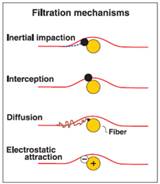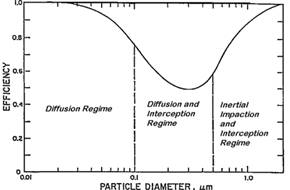Protecting Your Lungs from P2.5 Particles
Background
To understand the importance of protecting your lungs from P2.5 particles, you first have to understand what they are.
Particle pollution is a mixture of microscopic solids and liquid droplets suspended in air. This pollution, also known as particulate matter, is made up of a number of components, including acids (such as nitrates and sulfates), organic chemicals, metals, soil or dust particles, and allergens (such as fragments of pollen or mold spores).
Fine particle pollution or PM2.5 describes particulate matter that is 2.5 micrometers (microns) in diameter and smaller - 1/30th the diameter of a human hair. Fine particle pollution can be emitted directly or formed secondarily in the atmosphere. Examples: Sulfates are a type of secondary particle formed from sulfur dioxide emissions from power plants and industrial facilities. Nitrates, another type of fine particle, are formed from emissions of nitrogen oxides from power plants, automobiles, and other combustion sources. The chemical composition of particles depends on location, time of year, and weather.
Health studies have shown a significant association between exposure to fine particles and premature death from heart or lung disease. Fine particles can aggravate heart and lung diseases and have been linked to effects such as: cardiovascular symptoms; cardiac arrhythmias; heart attacks; respiratory symptoms; asthma attacks; and bronchitis. These effects can result in increased hospital admissions, emergency room visits, absences from school or work, and restricted activity days. Individuals that may be particularly sensitive to fine particle exposure include people with heart or lung disease, older adults, and children.
All particles smaller than 10 micron can be harmful but the smaller ones have a greater ability to penetrate deep into the lungs. Therefore government agencies from around the world have set 2.5 micron as the dividing point between coarse particles (>2.5 micron) and fine particles (<2.5).
The best ways to protect your lungs from inhaling fine particles is to stay away from any environment where the level of fine particles is high. Alternatively, if you must be in that area, wearing a tight fitting respirator that filters out fine particles is critical.
What type of respirator filters P2.5 particles?
When you are looking for a mask that filters P2.5 particles, it doesn’t mean that you only want to filter particles that are 2.5 micron in size. These are the largest of the fine particles you don’t want to breathe. If you look at the table in Appendix A, you will recognize that many of the particles you might be exposed to are much smaller than 2.5 micron. You want a respirator that filters even the very smallest particles, down to virus size.
How does a respirator filter mask work?
There are several mechanisms for a respirator mask to stop particles from penetrating through the filter while still allowing the air you need to breathe to get into your lungs. Most respirators stop particles by either electrostatic attraction (i.e., the particles stick to the mask) or by inertial impaction (the particles slam into the fibers and get stuck). The other two mechanisms include particle interception and diffusion. (See Figure 1). It takes a combination of these mechanisms to provide the maximum protection.
Figure 1 Filtration Mechanisms
 Very large particles in slow moving airstreams may settle out due to gravity. However, most respirable particles are too small for this mechanism. Respirable particles above 0.6 um in diameter may be captured by interception and inertial impaction. Inertial impaction occurs when a particle cannot follow a streamline around a fiber because of its inertia and instead impacts into the fiber. In the interception mechanism, the particle holds to the streamline, but that streamline will naturally bring the particle close enough to come in contact with the fiber.
Very large particles in slow moving airstreams may settle out due to gravity. However, most respirable particles are too small for this mechanism. Respirable particles above 0.6 um in diameter may be captured by interception and inertial impaction. Inertial impaction occurs when a particle cannot follow a streamline around a fiber because of its inertia and instead impacts into the fiber. In the interception mechanism, the particle holds to the streamline, but that streamline will naturally bring the particle close enough to come in contact with the fiber.
In contrast, diffusion mainly affects particles under 0.1 um. Random movements of air molecules cause these very small particles to wander across streamlines due to Brownian motion until they come in contact with a fiber. Because of the complex methods by which particulate filtration occurs, the smallest particles are not always the most difficult to filter. Electrostatic attraction is an entirely different particulate capture mechanism. Although it may be difficult to quantify the charge on either the particle or the fiber, electrostatic attraction can be an extremely effective means of capture. A charged particle will be attracted to fiber that has an opposite charge. In addition, a charged particle or fiber will induce an electrostatic field that will further serve to draw the two together.
Figure 2 Filtration Efficiency vs Particle Size
 Figure 2 shows the interaction of the different capture mechanisms on one type of filter media for the purpose of illustration. Filtration efficiency is shown as a function of particle diameter. While the filtration efficiencies are not representative of actual filters used in respirators today, it does demonstrate that most particulate filters have a region of minimum filtration efficiency somewhere between 0.05-0.5 um. Particles in this range are too large to be effectively pushed around by diffusion and too small to be effectively captured by interception or impaction.
Figure 2 shows the interaction of the different capture mechanisms on one type of filter media for the purpose of illustration. Filtration efficiency is shown as a function of particle diameter. While the filtration efficiencies are not representative of actual filters used in respirators today, it does demonstrate that most particulate filters have a region of minimum filtration efficiency somewhere between 0.05-0.5 um. Particles in this range are too large to be effectively pushed around by diffusion and too small to be effectively captured by interception or impaction.
As it turns out, the particle size that is the hardest to attract by electrostatic charge or diffusion mechanisms and also the hardest to stop by impaction or interception, is a particle that is 0.3 micron in diameter. As the smaller particles enter the mask fiber structure, the electrostatic charge on the fibers attracts the particles and they stick to it. Since the fibers in the mask are not lined up so there is a single channel through the mask, the air has to flow and change direction many times in that short distance between the outside surface and your airway. As the larger particles make the turns to follow the air, they crash (impact) on the fibers and get stuck, never entering your breathing space inside the mask. As previously stated, the 0.3 micron is not too small and not too large. It is just right to get through most filters. That is why respirators are tested to see how well they can filter out 0.3 micron particles. If they can filter these particles, they are considered to be the most effective for filtering all particles in the P2.5 range.
Can Respirators filter all small particles?
Two factors affect how efficient a respirator is at filtering the air you breathe. No disposable respirator can filter 100% of all particles because it is not just a matter of how good the filter is. The facial seal of facemasks is THE most important factor in protecting your lungs. Many respirators are not designed to seal well to your face so the reason that you find particles in your nose after using many masks is that there is no seal around the edges to your face. Particles get drawn into the mask from the edges and into your breathing zone. You might as well not be wearing any mask. With the silicone seal of our mask, you know that when you seal the mask to your face and test the seal, all of the air is being filtered.
However, even with a good seal, the mask will only filter a minimum of 95% of particles that are drawn into the mask surface. So there are still a small number of particles that can get past the protection of the mask. So when there is a choice, you should avoid contaminated areas. When there is no choice, there is no better choice for a mask to protect your lungs from P2.5 particles than ours.
Conclusion
While no mask can completely protect your lungs, knowing what particles are in the air around you and their particle size, can assist you in making the right decision to wear the right mask. And independent of the filtration capability of the mask, the seal against your face is the most import aspect to assure. On days that the air pollution index is high for P2.5 particles, you should be wearing a mask that can demonstrate that it filters out fine particles. Remember to protect your lungs.
Click here to see particle sizes (in microns) for most common particles

